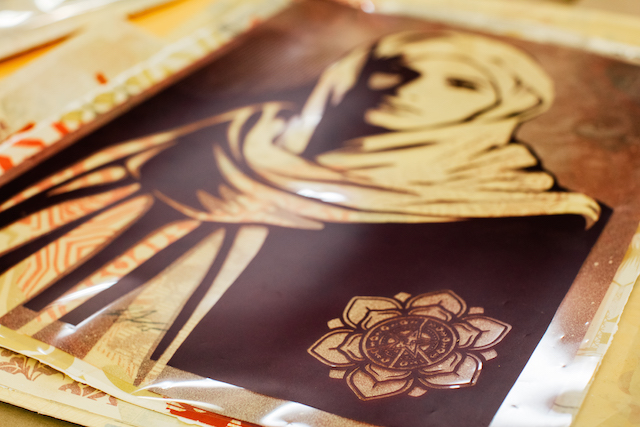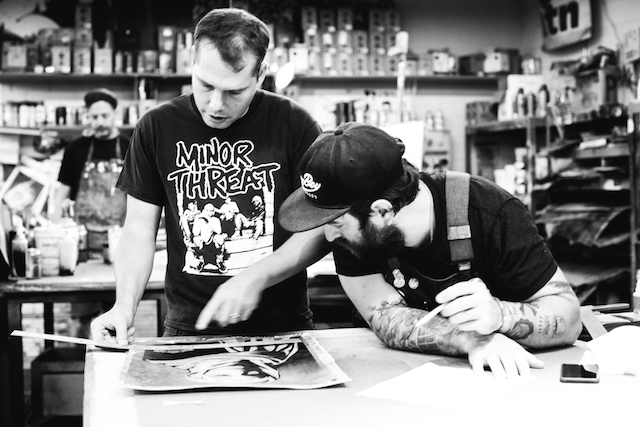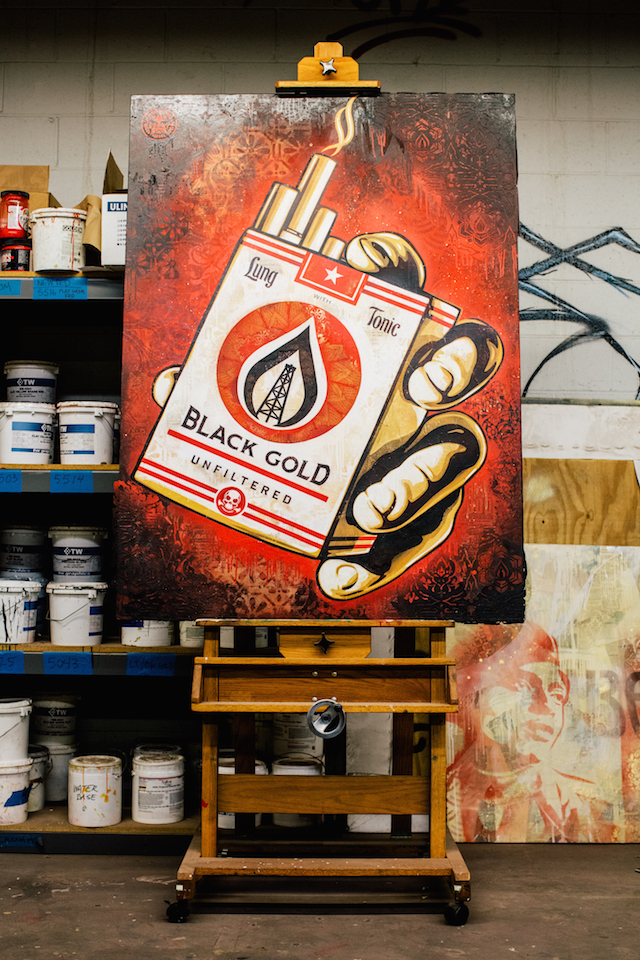
As the leading American street artist and one of the country’s most recognizable graphic designers, Shepard Fairey himself needs no introduction. But these are strange times for Fairey, and a refresher might be in order. His latest exhibition, On Our Hands at New York City’s Jacob Lewis Gallery, is set to open on Thursday evening. The show tackles the influence of money on politics, the way that legalized bribery has corrupted our democratic system. His new book, Covert to Overt, is due out later this month. The book tackles the influence of money on Fairey’s art, the way he’s fed his ever-growing fame and commercial success back into the work he’s always been doing. He’s on top of the world, or at least the art world. Except that Fairey also standing trial in Detroit for some wheatpastes that the city calls “malicious destruction of a building,” and he could wind up going to prison. So the next few months could really go either way.
Fairey has left an indelible mark on American politics and culture. No matter what happens next, I suspect he’ll continue on that path in one way or another. As he prepares for the opening of On Our Hands, we had the opportunity to ask Fairey a few questions about his career, his place in the art world, and his politics.
RJ Rushmore: As your own fame has grown, as you’ve gone from covert to overt, how have you learned to strike a balance between using your fame for positive change and simply enjoying it?
Shepard Fairey: There are pros and cons to being known whether you call it famous or infamous, but I definitely try to leverage my higher profile to push socially conscious and sometimes provocative ideas. I have a large audience now, which I view as a tremendous resource but also a group to be considerate of and responsible toward. It may sound trite but I take my situation seriously as, for lack of a better word, a role model. I try to provide strong justification for my actions and my viewpoints and I think one of the reasons many of the doors have opened for me that have, is because I’m community and socially minded, not only with my work but with the organizations I support and the activism I engage in.

RJ: What would you change about your manifesto if you were to rewrite it today, considering how the OBEY campaign has evolved? Or is the manifesto still, at its core, as valid as it was 25 years ago?
Shepard: Surprisingly I think it’s still valid in its principles but the Internet has changed the rate at which things can be demystified. The strength in 1990 of the curiosity around stickers and stencils appearing was that it created intrigue and conversations that revealed the Rorschach test component of the project. The OBEY GIANT project has always been about dialogue but now the dialogue may be a solitary one between the viewer and Google. I’m more interested in the human side of the interaction.
RJ: With decades of experience creating politically charged art, what helps you maintain the belief that change is possible, that art can be a catalyst for social justice and positive political change?
Shepard: I only have to look back at my transformation upon hearing the Dead Kennedy’s, Bob Marley, The Clash and seeing the art of Robbie Conal and Barbara Kruger to know that art can change the course of people’s lives. I make no claims about the effectiveness of every piece I make, or every statement I make, but I know that actions matter and that drives me regardless of all of the challenges in the world that seem insurmountable.

RJ: You’ve tackled police brutality in your work, and you gave Saber’s recent installation at the Long Beach Museum of Art a shout out, but you’ve stayed away from directly addressing the Black Lives Matter movement or structural violence against people of color. Is there a particular reason why?
Shepard: I support the Black Lives Matter movement and I recognize insidious racial bias that continues to be a major problem, but I think the police are frequently brutal indiscriminately. Statistics show that the police do act with a certain bias but I’d like to see their behaviors and methodology reformed across the board.
RJ: What are you doing for On Our Hands that you think pushes your work further than before or will surprise visitors?
Shepard: I’m putting more time into the depth of each image, not only in the painting of the primary imagery but the layering of the supplemental collage and stenciling that gives character to the surface and creates additional narrative elements. I think the pieces have become richer and more nuanced. I also have created some sculptural pieces that I think add conceptually and literally to the dimension of the work.

RJ: Even you readily acknowledge that campaign finance reform isn’t the sexiest issue in America. What sparked your interest in the topic, and why put the influence of money in politics at the center of On Our Hands?
Shepard: Democracy is supposed to give equal weight to each voter, if not equal weight to each citizen but current campaign finance structure more or less amounts to legalized bribery. Corporations and special interests that have deeper pockets can exert a disproportionate influence over politicians in a way that corrupts democracy. Studies have shown that the interests of the average person rarely impact legislation. The likelihood of a law being passed or blocked is almost wholly dependent on whether corporations and special interests support or oppose it. Campaign finance is not an easy thing to make art about but I enjoy the challenge of creating an image compelling enough to inspire people to look at an issue they might not otherwise care about. My life would be a lot easier if my art were completely decorative.

RJ: I remember, as a teenager with almost no knowledge of art, visiting bookstores just to flip through your book Supply and Demand and Banksy’s Wall and Piece, totally awestruck. For me, they were an introduction into something completely new. Now, Covert to Overt is primed to inspire a new generation of teenage artists and art-lovers. What do you hope they’ll take away from your new book?
Shepard: In a general sense, I hope that they will see that art can be appealing visually and deliver a message and that art can be valid in an ephemeral public forum as well as a more traditional art world setting. There is power in finding the best ways to navigate the needs of each platform. I began as an outsider and some would say I’m now an insider but I’ve maintained my outsider philosophy and my support for people who are marginalized or treated unjustly. I hope that the book will inspire any viewer to see that evolution and consistency are possible.
RJ: Will you be endorsing another presidential candidate anytime soon?
Shepard: The most important thing to me is overhauling the system because every candidate will be at the mercy of a dysfunctional Congress until we see campaign finance reform but I like the policy views of Bernie Sanders. I will not be doing a portrait of him; I’m using my art to place more emphasis on principles than personalities.
Shepard Fairey’s exhibition On Our Hands opens at Jacob Lewis Gallery on September 17th and runs through October 24th.
Photos courtesy Obey Giant Art via Shepard Fairey, and by RJ Rushmore
